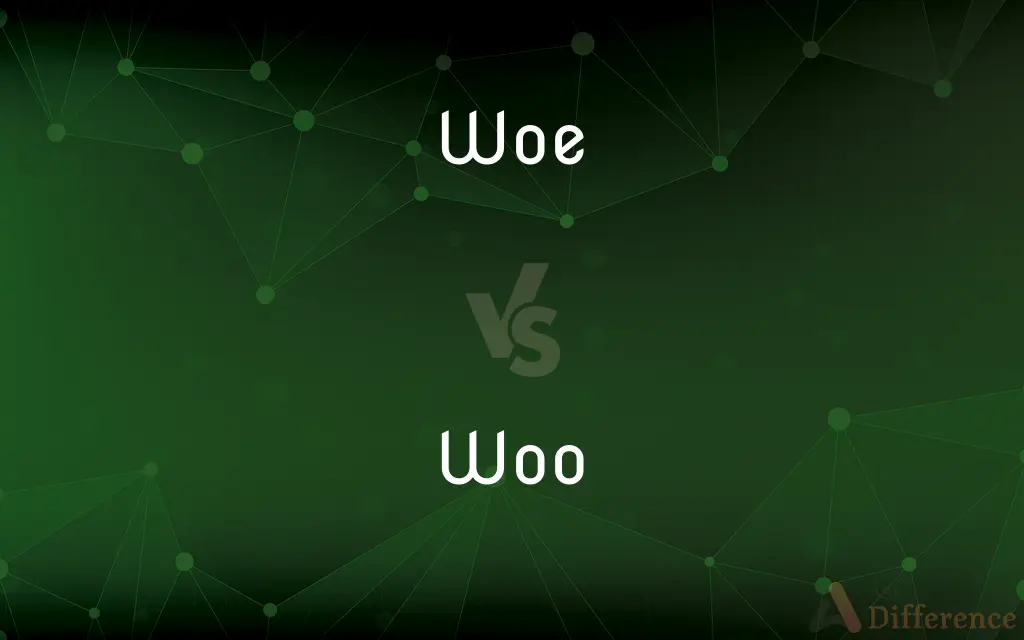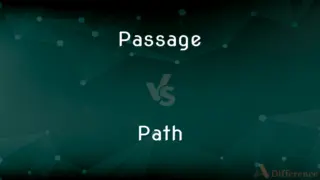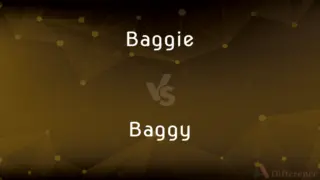Woe vs. Woo — What's the Difference?
By Maham Liaqat & Urooj Arif — Updated on April 19, 2024
Woe refers to great sorrow or distress, often used to express grief or despair; woo involves efforts to gain love, favor, or support, typically through persuasion or courtship.

Difference Between Woe and Woo
Table of Contents
ADVERTISEMENT
Key Differences
Woe is a term used to describe severe misery or distress, commonly associated with emotional suffering or tragedy. On the other hand, woo is the action of seeking to gain someone's love or approval, often through acts of affection, persuasion, or strategic appeal.
While woe often encompasses feelings of deep sadness or misfortune, such as in the aftermath of a disaster or personal loss, woo is associated with positive actions intended to attract or endear someone, such as during romantic pursuits or when trying to convince someone of a particular viewpoint.
The expression of woe is typically passive, reflecting a state of being affected by external circumstances or internal anguish. Conversely, to woo someone requires active engagement and deliberate strategies to elicit a favorable response or affection.
In literary contexts, woe is frequently depicted as a profound theme in tragedies and somber poetry, highlighting human suffering and existential angst. Whereas, woo often appears in romantic literature and comedy, focusing on courtship and the complexities of winning someone's heart.
Historically, expressions of woe have been important in cultural rituals and mourning practices, serving as a communal expression of grief or solidarity in suffering. In contrast, wooing practices have evolved culturally and socially, adapting to changing norms around relationships and attractions.
ADVERTISEMENT
Comparison Chart
Definition
Intense sorrow or distress.
Efforts to gain affection, favor, or support through persuasion.
Emotional Tone
Negative, associated with grief and despair.
Positive, associated with affection and attraction.
Type of Action
Passive expression of suffering.
Active pursuit of favor or affection.
Usage in Literature
Common in tragedies and reflective poetry.
Frequent in romantic and comedic contexts.
Cultural Significance
Often linked to mourning and expression of solidarity.
Tied to courtship customs and social relationship dynamics.
Compare with Definitions
Woe
Great sorrow or distress.
The woe felt by the community was palpable after the news of the tragedy.
Woo
To seek the affection or love of someone, particularly in a romantic context.
He decided to woo her with flowers and heartfelt poems.
Woe
An exclamation of grief or distress.
Woe unto those who ignore the lessons of history, he proclaimed.
Woo
To court or date someone attentively.
The young suitor wooed her by showing up every day with a new surprise.
Woe
A condition of deep suffering from misfortune, affliction, or grief.
His face showed the woe of a man who had lost everything.
Woo
To try to gain the favor, support, or custom of.
Politicians woo voters during election seasons with promises and speeches.
Woe
Misfortune or trouble viewed as inevitable or ordained.
Tales of ancient woes often warn of hubris.
Woo
To seek to persuade someone to support or use something.
The company wooed investors with an attractive offer.
Woe
Great sorrow or distress (often used hyperbolically)
The Everton tale of woe continued
Woo
To engage in romantic gestures to attract a partner.
He wooed his partner by planning thoughtful dates and experiences.
Woe
Sorrow or grief; misery.
Woo
To seek the affection of (someone, especially a woman) with the intent to marry or begin a romantic relationship.
Woe
Misfortune or wretchedness
Listened to his tale of woe.
Woo
To gain the favor of (someone) or move (someone) to do something by entreaties or inducements
An ad campaign that wooed customers away from their usual brand.
Woe
A cause of sorrow or misery; a misfortune
Economic and political woes.
Woo
To seek the romantic affection of someone, especially a woman.
Woe
Used to express sorrow or dismay.
Woo
(transitive) To endeavor to gain someone's support.
Woe
Great sadness or distress; a misfortune causing such sadness.
Woo
(transitive) (often of a man) To try to persuade (someone) to be in an amorous relationship with
Woe
Calamity, trouble.
Woo
(transitive) To court solicitously; to invite with importunity.
Woe
A curse; a malediction.
Woo
To solicit in love; to court.
Each, like the Grecian artist, wooesThe image he himself has wrought.
Woe
(obsolete) Woeful; sorrowful
Woo
To court solicitously; to invite with importunity.
Thee, chantress, oft the woods amongI woo, to hear thy even song.
I woo the windThat still delays his coming.
Woe
(archaic) An exclamation of grief.
Woo
To court; to make love.
Woe
Grief; sorrow; misery; heavy calamity.
Thus saying, from her side the fatal key,Sad instrument of all our woe, she took.
[They] weep each other's woe.
Woo
Seek someone's favor;
China is wooing Russia
Woe
A curse; a malediction.
Can there be a woe or curse in all the stores of vengeance equal to the malignity of such a practice?
O! woe were us alive [i.e., in life].
Woe unto him that striveth with his Maker!
Woe worth the chase, woe worth the day,That costs thy life, my gallant gray!
Woo
Make amorous advances towards;
John is courting Mary
Woe
Woeful; sorrowful.
His clerk was woe to do that deed.
Woe was this knight and sorrowfully he sighed.
And looking up he waxed wondrous woe.
Woe
Misery resulting from affliction
Woe
Intense mournfulness
Common Curiosities
Can woe and woo coexist in a story?
Yes, many stories combine elements of woe, such as tragic events, with woo, such as romantic endeavors, to create complex narratives.
How do expressions of woe impact people?
Expressions of woe can provide a sense of relief, shared understanding, and community support, helping individuals cope with grief or distress.
What is the main difference between woe and woo?
Woe is an expression of deep sorrow or distress, while woo is the act of seeking someone's love or approval through persuasive actions.
What are some effective strategies to woo someone?
Effective strategies to woo someone include showing genuine interest, consistent kindness, thoughtful gifts, and clear communication of intentions.
How is woe typically expressed in culture?
Woe is often expressed through mourning rituals, art, and literature as a way to process and articulate deep emotional pain.
Can wooing be non-romantic?
Yes, wooing can also refer to efforts to persuade or gain the favor of others in non-romantic contexts, such as in business or politics.
What role does woo play in literature?
Woo often drives the plot in romantic literature, serving as a key element in the development of relationships between characters.
Is woe always a result of external events?
Woe can be triggered by external events or internal conflicts, embodying a response to various types of adversity.
Can wooing affect the outcome of elections or business deals?
Yes, effectively wooing voters or clients can significantly sway elections and business outcomes by influencing decisions and loyalty.
Why is wooing important in relationships?
Wooing is important as it helps build mutual attraction and respect, laying the foundation for a strong and enduring relationship.
How do modern representations of woe differ from historical ones?
Modern representations often emphasize personal emotional journeys, while historical ones might focus more on communal or epic tragedies.
What are the psychological effects of experiencing woe?
Psychological effects can include depression, anxiety, and a profound sense of loss, but can also lead to personal growth and resilience.
How do cultural differences affect wooing practices?
Cultural differences can significantly affect wooing practices, with varying norms around dating, gifts, and expressions of affection.
What are the risks of wooing someone?
Risks include potential rejection, misunderstanding, or the creation of one-sided expectations in the relationship.
How do societies help individuals cope with woe?
Societies offer support through community services, rituals, shared expressions of grief, and social solidarity to help individuals manage woe.
Share Your Discovery

Previous Comparison
Passage vs. Path
Next Comparison
Baggie vs. BaggyAuthor Spotlight
Written by
Maham LiaqatCo-written by
Urooj ArifUrooj is a skilled content writer at Ask Difference, known for her exceptional ability to simplify complex topics into engaging and informative content. With a passion for research and a flair for clear, concise writing, she consistently delivers articles that resonate with our diverse audience.
















































